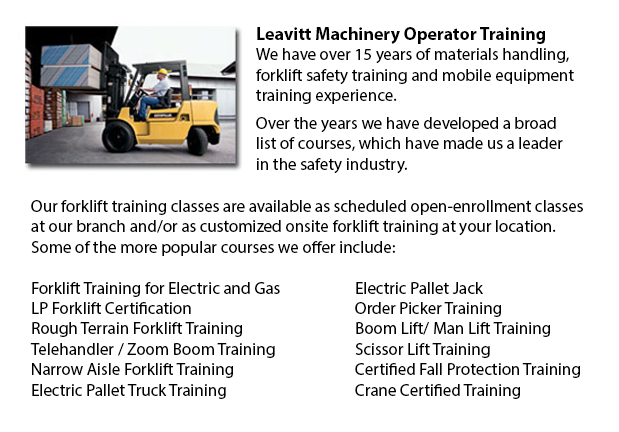
Forklift Training Schools Red Deer - Have An Efficient And Safe Work Place With Our Forklift Training Schools
Are you looking for work as a forklift driver? Our regulatory-compliant mobile equipment operator training offers instruction in types of lift trucks, pre-shift inspection, fuel types and handling of fuels, and safe operation of a lift truck. Hands-on, practical training helps individuals participating in obtaining essential operational skills. Program content covers current rules governing the operation of forklifts. Our proven forklift Schools are designed to provide training on these types of trucks: counterbalanced forklift, powered pallet trucks and narrow isle forklift.
When the forklift is in use, do not raise or lower the forks. Loads should not extend above the backrest. This is because of the possibility of the load sliding back in the direction of the operator. Check for overhead obstacles and make sure there is plenty of clearance before lifting a load. Stay away from overhead power lines. When the load is lifted straight up, tilt it back slightly.
While the load is lifted the lift truck will be less steady. Make sure that no pedestrians cross below the elevated fork. The operator must not leave the forklift while the load is raised.
When handling pallets, forks should be high and level enough to go into the pallet and extend all the way below the load. The width of the forks should provide even distribution of weight.
Chock the wheels and set the brakes prior to loading and unloading the truck. The floors must be strong enough to support the combined weight of the load and the forklift. Fixed jacks can be installed in order to support a semi-trailer that is not attached to a tractor. The height of the entrance door should clear the height of the forklift by a minimum of 5 cm. Mark edges of ramps, docks or rail cars and avoid them.
-
Fall Protection Ticket Red Deer
Fall Protection Ticket Red Deer - The number one reason of death in the construction industry come from fall-related incidents. There is more possibility for fall accidents depending upon the kinds of work being done in your workplace. Therefore, kno... More -
Overhead Crane Certification Red Deer
Overhead Crane Certification Red Deer - The overhead crane certification course is a course that is designed to help trainees, even if they have language or literacy limitations. The course comprises a practical hands-on training session and a classr... More -
Wheel and Track Loader Training in Red Deer
Lift trucks are obtainable in a variety of various models which have various load capacities. Nearly all typical lift trucks utilized in warehouse settings have load capacities of 1-5 tons. Bigger scale models are utilized for heavier loads, like for... More -
Heavy Equipment Certification Red Deer
Heavy Equipment Certification Red Deer - Heavy duty vehicles are big pieces of machines which are usually known as heavy equipment. It is a broad term that literally includes whatever big utility vehicle in the area of agricultural and forestry imple... More -
Heavy Equipment Operator Classes Red Deer
Heavy Equipment Operator Classes Red Deer - A person who has the correct training to be able to use a particular kind or piece of machine is referred to as an equipment operator. There are different ways that an equipment operator can become trained... More -
Forklift Training Programs Red Deer
Forklift Training Programs Red Deer - Are you searching for a job as a driver of a forklift? Our regulatory-compliant mobile equipment operator training offers instruction in kinds of lift trucks, pre-shift check, fuel types and dealing with fuels, a... More -
Crane Safety Training Red Deer
Crane Safety Training Red Deer - Both crane driver and their supervisors must know all the potential problems related to the operation of an overhead crane. All over North America, there is legislation which provides rules for the safe inspection, ma... More -
Aerial Lift Training Red Deer
Aerial Lift Training Red Deer - An aerial work platform is a mechanized access platform. This device provides access to otherwise inaccessible places for people or equipment. Likewise called an elevating work platform or aerial device, the machinery... More

Forklift Training Red Deer
TOLL FREE: 1-888-254-6157
Red Deer, Alberta
forklifttrainingreddeer.com
Email Us
About Us


